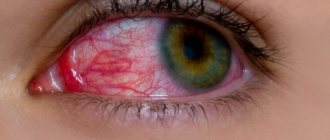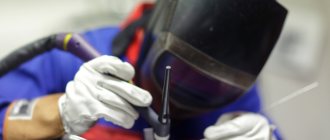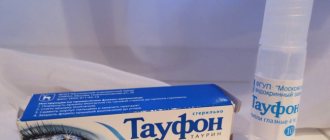The article was prepared by a specialist for informational purposes only. We urge you not to self-medicate. When the first symptoms appear, consult a doctor.
People who weld as part of their job or simply use this technology in home repair work know the expression “catching bunnies.” In welding parlance, this means getting eye disease from working with welding equipment without safety glasses. Among doctors, such damage to the organ of vision is called “photokeratitis” or “electro-ophthalmia”. It occurs when the cornea of the eye is exposed to a powerful stream of ultraviolet radiation.
In order to understand the mechanism of its development and possible methods of prevention, it is necessary to dwell in more detail on the physical and physiological basis of ultraviolet rays.
A bit of physics and technology
In most types of welding that are used in construction, the connection of products occurs under the action of a welding arc. A welding arc is an electric charge that arises between two electrodes in a mixture of gases, has high power and persists for a long time. It has ultra-high temperature and high current density. The physical properties of the welding arc are such that when it is formed, an additional release of a large flux of ultraviolet radiation occurs.
Ultraviolet radiation is radiation with a wavelength from 10 to 400 nm. Occupies an intermediate position between visible light, whose wavelength exceeds 380 nm, and X-ray radiation with a wavelength shorter than 10 nm.
Ultraviolet radiation is not uniform and can be divided into four parts depending on its wavelength. There are:
- UVA rays, or near ultraviolet, with wavelengths of 315-400 nm;
- UV-B rays, or 280-315 nm;
- UV-C rays, or far ultraviolet, with wavelengths of 100-280 nm;
- extreme ultraviolet 10-100 nm.
The biological effect that ultraviolet radiation has on the human body directly depends on its wavelength. The longer they are, the weaker the influence.
UVA rays are practically not felt by humans.
Ultraviolet rays with a length of 280-315 nm have a strong effect on the skin and mucous membranes and, with prolonged exposure, can cause burns.
The most aggressive are UV rays shorter than 280 nm, which can easily penetrate deep into the tissues of the body. For example, they can pass through all media of the eye and reach the retina, causing its damage.
The composition of ultraviolet radiation arising in the welding arc is dominated by UV rays with a wavelength from 100 to 300 nm.
How is eye injury treated?
Treatment is selected based on the type and extent of eye damage. In mild cases, we manage with drug therapy, which includes antibacterial drugs, non-steroidal anti-inflammatory drugs, painkillers and hormonal eye drops. For moderate and severe burns, the patient is hospitalized; for serious wounds, surgery is performed. Treatment after an eye injury involves using drops recommended by your doctor.
Consequences of eye injury
The consequences of damage depend on its extent and the quality of assistance provided. Doctors treat wounds and carry out all necessary manipulations, so if you quickly go to the emergency room, there will be fewer complications. Undesirable consequences are associated with infection entering the blood or even greater injury as a result of rash actions.
If a person does not receive timely medical care, scars remain, the soft tissues around the eye are deformed, and visual acuity decreases until it is completely lost.
If the infection enters the blood, sepsis develops - inflammation that is dangerous to the entire body. Accumulating pus affects the internal structures of the eye, sometimes reaching the brain, causing inflammatory processes in the body.
A little medicine
The outside of the eye is covered with a special transparent structure called the cornea. It is a lens consisting of transparent connective tissue covered on the outside with epithelium. Its cells are capable of absorbing ultraviolet radiation. The reaction of the cornea to UV rays depends on their wavelength, time and intensity of exposure. With prolonged exposure to a powerful stream of short-wave UV radiation, the DNA of epithelial cells is destroyed. As a result, their death develops, which manifests itself in the form of a burn.
In response to UV rays, an inflammatory reaction occurs in the cornea, which is characterized by four classic symptoms:
- swelling;
- redness;
- increased body temperature;
- pain.
These clinical signs develop due to the reaction of blood vessels and nerves entwining the anterior surface of the eyeball.
Under the influence of UV rays, small capillaries located at the junction of the cornea and the sclera expand, causing it to swell. Dilated, blood-filled vessels of the conjunctiva give it a red color.
The cornea is rich in nerve endings, so any damage to it causes severe pain.
Full restoration of its functions occurs within 3-4 days.
A distinctive feature of a burn with UV rays from thermal and chemical burns is that its effect is cumulative, that is, accumulative. Symptoms do not appear immediately after exposure, but appear gradually, reaching a maximum 6-12 hours after injury.
What to do if you catch bunnies: first aid
Know! Since eye burns from welding always occur in industries where there is no doctor, in such situations it is first necessary to provide the victim with emergency assistance, which consists of the following:
- be rinsed with running cold water for several minutes to eliminate painful sensations.
- If the burn is accompanied by electrode particles , they must be removed with the corner of a folded napkin or a clean handkerchief.
- It is advisable to apply compresses soaked in antiseptic ointment to your eyes , if you have one in your medicine cabinet.
- If you experience severe pain, you can take painkillers orally.
If you have ice on hand, you can apply pieces of it to the victim’s closed eyelids.
Remember! In the process of providing first aid, it is necessary to call an ambulance or, if possible, independently deliver the victim to the nearest clinic.
Signs of eye burns from UV rays
The main complaints in case of eye burns from welding are:
- Pain in the eyes;
- feeling of sand, specks in the eye;
- lacrimation;
- spasm of the eyelids (blepharospasm);
- photophobia;
- decreased visual acuity;
- headache;
- increase in body temperature (not higher than 38 C°)
When examining the eye, swelling of the cornea is noted, it becomes looser, thickens, loses its natural shine, and may become cloudy. In severe cases, erosions and bubbles form on its surface. The vessels of the conjunctiva are clearly visible, filled with blood - “red eyes”.
Which drops after welding to choose
The choice of medicine is made based on the stage of the burn. Each stage has its own symptoms.
First stage
Characteristic symptoms:
- Very severe itching;
- Redness of the whites of the eye, which can be regarded as minor. Characterized by a faint pink color;
- Burning;
- Cloudy iris.
During this period, the use of drops after welding is the most effective means for therapy and prevention of the development of the disease.
What medications will be needed:
- Anesthetic drops after welding. They will help relieve all unpleasant symptoms: pain, itching, feeling of sand in the eyes and others;
- Vasoconstrictor drops. They will relieve swelling and inflammation;
- Antibacterial drops. They will prevent infection from developing and accelerate tissue regeneration.
Therapy is carried out for 2-3 days; if symptoms do not go away or worsen, you should urgently consult a doctor.
Second stage
Characteristic symptoms:
- Erosion of the cornea of the eye;
- The conjunctiva is covered with a film;
- Severe photophobia, resulting in spasms;
- Very strong sharp pain when moving the eyeballs.
At this stage, to treat an eye burn, it is possible to use the above types of drops.
There are also third and fourth stages. Self-treatment is not recommended. These are very difficult stages, at the fourth stage tissue necrosis is already possible and only surgical intervention will help here. At these stages, the use of any medications in the form of drops is practically useless.
Important: do not delay your visit to the doctor! Be sure to tell us exactly which drops after welding were used for treatment.
First aid
Any phototrauma of the eye requires a mandatory visit to an ophthalmologist to assess the degree of damage to the cornea.
To relieve symptoms at home, before consulting a doctor, you can use:
- sunglasses, darkening windows with curtains, using night lights;
- painkillers and anti-inflammatory drugs by mouth;
- natural tear preparations.
The protective regime is of great importance precisely in the first day after the onset of symptoms, when photophobia and blepharospasm are most pronounced. Using sunglasses, avoiding bright lamps, and darkening windows with curtains will help your eyes get through this difficult period easier.
There is no need to apply protective bandages to the eyes, as they slow down the healing process of the cornea and create additional discomfort for the victim.
To relieve pain, painkillers such as Nurofen, Indomethacin, Nimesil, Diclofenac in tablets and capsules can be used. Use 1 tablet (capsules) 2-3 times a day after meals for 3 days.
To speed up the healing of epithelial damage and prevent corneal dryness, natural tear preparations can be used, for example, Visin Pure Tear, Natural Tear. They are instilled 1-2 drops into each eye every 2 hours.
Prohibited:
- instill any drops into the eyes, except those written above, without first consulting a doctor;
- use traditional medicine methods (tea lotions, honey solution, aloe) in the first day after injury;
- rub your eyes.
Treatment prescribed by an eye doctor. After consultation, the ophthalmologist may prescribe:
- antibiotics in the form of eye drops, this is necessary to prevent the development of microbial inflammation of the injured cornea;
- anesthetic solutions (lidocaine, dicaine) to relieve pain in the eyes;
- perivasal novocaine blockades (carried out in a clinic);
- medications that dilate the pupil.
Complications of corneal burns during welding. Late seeking medical help can cause the development of the following pathological changes in the cornea:
- cloudiness with the development of a cataract;
- scarring;
- ulcers;
- chronic inflammation.
Symptom from a medical point of view
“Bunnies” are a manifestation of electrophthalmia, which occurs due to exposure of the organs of vision to strong ultraviolet radiation, which can damage the retina, mucous membrane, cornea and other elements of the eye .
Important! In the first few minutes and sometimes hours, the consequences of such a burn may not appear, but subsequently the victim experiences a number of symptoms that may vary depending on the extent of the injury.
In ophthalmology, electrophthalmia is divided into four degrees :
- First degree . Redness of the conjunctival membrane is observed, increased lacrimation and slight pain appear, the cornea in some cases becomes slightly cloudy.
- Second degree . Ulcerations and erosions form on the cornea, opacities become more noticeable, and a film forms on the conjunctival membrane, which is easily separated over time.
- Third degree . The cornea becomes so cloudy that it becomes opaque. Signs of necrosis appear on the tissues of the eye and on the skin around the organs of vision, and the films formed on the conjunctiva are separated with difficulty or not at all.
- Fourth degree . Maximum clouding of the cornea is observed, which becomes completely opaque. Irreversible necrotic processes occur, affecting the conjunctiva and deep tissues of the eye.
We can talk about a favorable outcome in the first two degrees, and in these cases, sometimes treatment with folk remedies at home is sufficient, although it is still worth seeing a qualified specialist.
Prevention
Since any illness or injury is easier to prevent than to treat, compliance with safety rules when welding works plays a major role in the prevention of electroophthalmia.
A properly fitted welder's mask will protect your eyes from the harmful ultraviolet radiation of the welding arc.
Author of the article:
Volkov Dmitry Sergeevich |
Ph.D. surgeon, phlebologist Education: Moscow State Medical and Dental University (1996). In 2003, he received a diploma from the educational and scientific medical center for the administration of the President of the Russian Federation. Our authors
Eye drops after welding for quick regeneration
If the above complex treatment relieves the symptoms of an eye burn after welding, you need to use drugs that ensure the regeneration of injured tissue.
You can use various products in small courses so that they are not addictive and help restore your eyes faster.
According to ophthalmologists, the use of the following medications is recommended:
- Emoxipin. The main direction of action is to help in the resorption of hemorrhages, tissue regeneration, strengthening of blood vessels;
- Derinat. These eye drops after welding help solve the main problem of the burn - restore the gas mucosa and prevent the formation of scars;
- Vitasik. General action drops have an effect on the mucous membrane and restore nerve endings.
During use, it is important to adhere to the recommendations and dosages that are contained in the instructions for using eye drops after welding.
What not to do if you have an eye injury after welding.
- No need to scratch your eyes. Or trying to get sand that you feel in your eye. It is not there, it is a symptom of inflammation and mechanical impact will increase the pain;
- Do not wash the injured eye with water. The weld burn does not require cooling. There are erosions on the mucous membrane and trace elements contained in water will only increase inflammation;
- In the acute stage of a burn, you cannot use well-known folk remedies: tea leaves, honey, aloe and others. They will only bring additional inflammation, allergic reactions and other undesirable consequences. It is generally better not to use such methods. There are a huge number of specialized eye medications on the pharmacy market;
- You cannot independently prescribe treatment and dosage of eye drops after welding. The best treatment will be prescribed by your doctor. Drops can be used urgently.
Doctors' recommendations
To get the maximum effect from treatment, you should not only follow the correct use of eye drops, but also a number of other recommendations:
- Do not rub your eyes after getting a burn. This will only make the pain worse.
- Rinse eyes only with distilled water, do not use tap water.
- If possible, remove metal particles from the eye. If it causes severe pain, call an ambulance. Close your eyes and give them a little rest before she arrives.
- If you manage to remove metal particles, you can use eye drops.
- Symptoms do not appear immediately. It increases over 7 hours. Therefore, after scale gets into the eye, immediately contact an ophthalmologist and begin immediate treatment.
- After treatment, pain may remain; this is due to the restoration of the epithelium, which takes a long time to heal. Thermal injury does not go away quickly. Long-term therapy is required, even after the acute phase disappears.
- You cannot work with eye burns. It is important to give them rest during treatment, so healing will go faster. You should watch less TV, work at the computer, and preferably stay in dust-free and sufficiently humidified rooms.
- You can use traditional methods of treatment. For example, chamomile decoction, tea leaves, honey, potato masks. Traditional methods of treatment are not recommended to be used without consultation; sometimes they are prohibited due to the serious condition of the patient.
What not to do
It’s not enough to know what to put on your eyes after welding; you also shouldn’t forget about prohibited activities. This will help to avoid unpleasant consequences in the future.
Basic prohibited recommendations:
- In no case should you rub your visual organs too hard;
- no need to rinse your eyes from the tap;
- immediately after receiving damage there is no need to use folk remedies;
- Is it possible to put Lidocaine and other drops into the eyes after welding? It is better not to do this; you should first consult a doctor.
If after welding there are unpleasant feelings in the eyes, pain, swelling, then you should immediately consult a doctor. However, it is not always possible to quickly visit an ophthalmologist; in this case, first aid must be provided. If severe pain is noted, you can drip Novocaine for the eyes after welding. This will alleviate the condition, but for a few hours. And you definitely need to get to an ophthalmologist as soon as possible, only he will be able to determine the extent of the damage, and then select the most appropriate treatment.
How long will the illness last?
If the eye is damaged by welding, symptoms may not appear until seven hours later. If the corneal layer is not damaged, the disease will last several days. You will notice: lacrimation, photophobia, anxiety. Over time this will pass. If the presence of a burn is established, the doctor will prescribe treatment, the duration of which is directly dependent on how severe the injury is. Even after completing the full course, discomfort may occur.
There is no need to hope that a thermal burn will go away quickly. It may take a long time for complete recovery. Therefore, even if you feel relief, complete the full course of treatment prescribed by your doctor. In order not to miss procedures, it is better to issue a sick leave.
How to remove pain
In any case, when, upon completion of welding, the operator experiences pain and discomfort in the area of the pupils, he should be provided with pre-medical first aid.
Most often it is expressed in washing the eyes with a previously prepared solution of potassium permanganate or a significant amount of absolutely clean boiling water (after it has cooled).
In a situation where small particles of welding waste get into the eyelids when splashed, they should be carefully removed with medical tweezers, a clean handkerchief or a moistened cotton swab.
If a welder complains of severe pain and burning in the eyes, doctors recommend a corneal anesthetic medicine such as Lidocaine. It is used in the form of a two percent aqueous solution.
The patient is given Tavegil or Diclofenac as anti-inflammatory drugs. From the category of oral painkillers, after receiving it, you can use any analgesic.
We would like to pay special attention to the fact that in case of a burn or other damage to the cornea due to welding, it is strictly forbidden to rub your eyes too hard. Any attempt to solve the problem that has arisen in this way can only lead to increased itching and the appearance of blepharospasm
Further irritation of the cornea can increase the feeling of discomfort and provoke inflammation of the organ of vision.
If it is not possible to remove a small metal particle from the eye using traditional welding methods, doctors give an injection of a calcium solution that helps clean the mucous membranes. After the injection, tetracycline ointment is required to be placed under the eyelids, used as an antiseptic.
Drops for the treatment of the first stage
At the first stage of a burn to the organs of vision, drops are used to relieve inflammation, relieve pain and constrict blood vessels. These medications help reduce inflammation, redness, and provide short-term pain relief:
- Proculin;
- Lidocaine;
- Visine;
- Tetracaine;
- Alcaine;
- Diclofenac;
- Diklo-F;
- Visoptic;
- Visoptin.
These drugs help relieve all signs of the first stage of burns that the patient received from welding. Some of them create a freezing effect, relieving pain for a long time. It is not recommended to use such medications more than twice a day.
Severe burn
When a severe injury occurs, the cornea of the eye suffers greatly. Doctors note severe clouding of the corneal tissue, and this directly affects vision.
The following symptoms are typical for this degree of burn:
- Constant sensation of a foreign object;
- Severe swelling of the eyelids;
- Severe aching pain;
- Decreased visual acuity (white veil before the eyes).
If you receive such a burn from welding, you must immediately go to the hospital. Delay can threaten, at best, with eye diseases in the future, and at worst, partial or complete loss of vision.
Important: in case of severe injury, the success of treatment directly depends on the promptness of contacting a doctor.
The effectiveness of using drops for chemical burns
Of all the types of external damage, only two require truly urgent care - occlusion of the central retinal artery and chemical burn of the eye. Delay in such a situation can lead to complete loss of vision. Chemical damage to the eye is the only emergency condition in ophthalmology where therapy is started without measuring visual acuity.
First, the affected area is thoroughly washed. For this purpose, an isotonic sterile solution is used in a hospital setting.
For preventive purposes, antibacterial drops are instilled into the affected eye 3-5 times a day.
To suppress the development of the inflammatory process, combinations of drugs containing glucocorticoids and antiseptics are prescribed.
It is not advisable to use aminoglycosides in the treatment of a chemical burn of the eye, since they interfere with the restoration of the epithelium.
The pain syndrome is relieved with analgesic drops. Depending on the degree, additional analgesics and tranquilizers may be prescribed orally.











